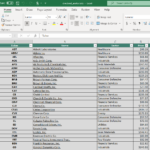Forecasting inflation is a notoriously difficult business, which means we have to set expectations. After all, if I were a good inflation forecaster, I would probably be investing on it not writing about it.
Modern economic theory posits that actual inflation depends on expected future inflation — that what inflation will be is in part a function of what people think it will be. Indeed, Jerome Powell often cites the US Federal Reserve’s assessment of inflation expectations in both his post-Federal Open Market Committee (FOMC) press conferences and congressional testimony.
If expectations influence the Fed’s decision-making process, then investors who hope to forecast inflation have two important questions to answer: What inflation expectation metrics should they focus on, and what should their time horizon be?
According to the current Monetary Policy Report to the Congress, policymakers examine several inflation expectation measures: those from financial market participants and staff economic models as well as the consensus of professional forecasters and surveys of households and businesses. Their time horizons are just as critical. Over shorter time periods, realized inflation may evolve in response to non-monetary factors, as we saw during the pandemic.
So, how accurate are the short- and long-term realized inflation forecasts of consumers and economists? Do they have implications for the future direction of monetary policy? Let’s see.
The Data
The proxy for consumer inflation expectations in this analysis is the University of Michigan’s Survey of Consumers. Released on a monthly basis, the survey gives the US public’s short- and long-term expected inflation outlook over the next 12-months and five years. Data on the 12-month expectations go back to 1978, while the five-year expectations data is spottier, with consistent monthly readings only available since 1990.
The Federal Reserve Bank of Cleveland’s Inflation Expectations model is the metric for economists’ inflation expectations, which charts them 1, 5, and 10 years ahead. The model’s data begins in 1982, and its key inputs include the Blue Chip CPI forecast, current month and historical CPI, short- and long-term Treasury yields, and the Survey of Professional Forecasters median year-over-year (YoY) CPI inflation rate, among other variables.
CPI and Core CPI are the inflation metrics I rely on here. While the former is most relevant for consumers, policymakers tend to focus on less volatile “core” statistics. For a directional comparison with other expectation metrics, I use CPI and Core CPI on a YoY and five-year annualized basis.

The Results
Twelve-Month Expectations vs. Realized Inflation
The following charts present the University of Michigan survey and the Cleveland Fed inflation expectations for the next 12 months compared with the realized YoY change in CPI and Core CPI, respectively. More specifically, I lag the YoY change in CPI and Core CPI by 12 months to show where inflation was the next year. This way, we see where consumers and economists predicted inflation to be and where it ended up 12 months later.
12-Month Forecasts and Realized CPI

12-Month Forecasts and Realized Core CPI

The plots show that neither economist nor consumer estimates tracked future inflation especially well. With respect to CPI, diverging realized and expected values dominate the plot. Core CPI forecasts look a bit more accurate. In particular, the mid-1990s predictions show considerable alignment within the series. More recently, during the 2010s, the economist forecast does a decent job anticipating the average level of inflation, albeit with much higher volatility than Core CPI.
One other interesting observation: Since around 2000, consumer inflation expectations have been consistently higher than those of economists. Through the 2010s, they were much higher than both realized CPI and Core CPI. In general, consumers and economists both missed the post-pandemic inflation surge.
But what about forecasts for other time horizons? The following plot illustrates the rolling three-year correlation between the forecast measures and realized inflation.
One-Year CPI and Core CPI Inflation vs. Estimates

While CPI, Core CPI, and expectations measures show some correlation during the 1990s, the relationship is highly unstable. During the 2010s, across all the measures, the correlations are more negative than positive. Forecasts from both consumers and economist were well off the mark not only in the degree of anticipated inflation but also often in the direction of inflation.
The table below charts the root mean-squared error (RMSE) and R2 from regressions of the forecasting variables against CPI and Core CPI, as well as the standard deviations of CPI and Core CPI.
12-Month Inflation and Inflation Expectations: Sample Statistics and Forecast Accuracy
| CPI | Core CPI | |
| Standard Deviation | 0.0159 | 0.0127 |
| RMSE | Adjusted R2 | |
| Economists (Cleveland Fed) vs. CPI | 0.0154 | 7.5% |
| Consumers (University of Michigan) vs. CPI | 0.0156 | 5.0% |
| Economists vs. Core CPI | 0.0098 | 39.7% |
| Consumers (University of Michigan) vs. Core CPI | 0.0110 | 24.4% |
Were economist and consumer forecasts reliable predictors of future inflation, we would expect high adjusted-R2s and for RMSEs to be well below the standard deviations of CPI and Core CPI. But forecasts from both cohorts of 12-month CPI were inaccurate. The RMSEs are nearly the same as the standard deviation of CPI, and adjusted-R2s s are very low, indicating that the regressors don’t explain much of the year-to-year variation.
The Core CPI measures are much more accurate, however, with lower RMSEs and with economists forecast accounting for roughly 40% of the Core CPI variation. The University of Michigan statistics tell a similar story, though economists show a predictive edge over consumers. The lower overall variance of the Core CPI helped both groups anticipate 12-month forward inflation.

The Results: Five-Year Expectations vs. Realized Inflation
Since non-monetary policy factors influence near-term inflation, short-term forecasting may be more difficult. Perhaps consumers and economists can better predict long-run inflation as short-term fluctuations in the change in the price level “even out.” To evaluate this hypothesis, I extended our time horizon from one to five years.
So, how does the five-year annualized change in inflation compare with the five-year forecast from the Cleveland Fed and the University of Michigan surveys?
Five-Year Forecasts and Realized CPI

Five-Year Forecasts and Realized Core CPI

Once again, the forecast variables and both headline and core inflation statistics show considerable divergence. The Cleveland Fed estimate is at least directionally accurate inasmuch as it declined for the better part of 30 years along with inflation. The University of Michigan survey estimates have consistently exceeded CPI and Core CPI and did not predict inflation well at all. Taken in July 2018, the last observation of the forecast variables failed to anticipate inflation in July 2023, and both failed to predict the inflation spike of the last two years.
Five-Year CPI and Core CPI Inflation vs. Estimates

The rolling correlation plot confirms some of these informal observations. The economist estimate has generally only weakly correlated with CPI over the last 15 years or so. The University of Michigan survey has hardly shown any predictive ability at all, with mostly negative correlations for much of the last 20 years. Indeed, the rolling correlation plots do not suggest a stable relationship between expectations and realized inflation.
Five-Year Inflation and Inflation Expectations: Sample Statistics and Forecast Accuracy
| CPI | Core CPI | |
| Standard Deviation | 0.0061 | 0.0048 |
| RMSE | Adjusted R2 | |
| Economists (Cleveland Fed) vs. CPI | 0.0056 | 16.6% |
| Consumers (University of Michigan) vs. CPI | 0.0061 | 1.1% |
| Economists (Cleveland Fed) vs. Core CPI | 0.0042 | 23.6% |
| Consumers (University of Michigan) vs. Core CPI | 0.0043 | 20.4% |
The summary statistics of the economist estimates demonstrate only a modest ability to predict five-year inflation. The R2 for five-year CPI is higher than that from the earlier 12-month regression. This implies that economists’ structural models benefit from the longer time horizon. The University of Michigan survey does not indicate a meaningful relationship with CPI, but the Core CPI statistics do improve and are broadly in line with the economists’ predictions of Core CPI. On the whole, the regressions do not suggest forecasting long-run inflation is easier. In fact, in several cases, the performance deteriorates.

What’s Next?
According to economic theory, managing expectations is key to keeping inflation in check. But economist and consumer expectations of future inflation have proven widely off the mark over the short and long run. On balance, economists fare slightly better than consumers, but their advantage is small and confined mostly to short-run Core CPI.
To be sure, there are other inflation measures than those used here, such as PCE, median CPI, “sticky” indices, etc., as well as other gauges of inflation expectations, whether they are market based, business surveys, etc. But if, as this analysis demonstrates, the most common metrics fail to predict inflation with any certitude, it casts considerable doubt on the utility of inflation forecasting altogether.
That is, inflation forecasting may not only be tricky but also a waste of time.
If you liked this post, don’t forget to subscribe to the Enterprising Investor.
All posts are the opinion of the author. As such, they should not be construed as investment advice, nor do the opinions expressed necessarily reflect the views of CFA Institute or the author’s employer.
Image credit: ©Getty Images / Dina Belenko Photography
Professional Learning for CFA Institute Members
CFA Institute members are empowered to self-determine and self-report professional learning (PL) credits earned, including content on Enterprising Investor. Members can record credits easily using their online PL tracker.














